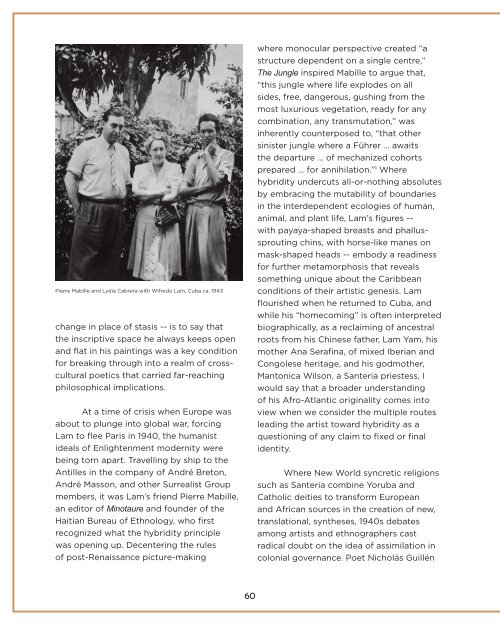Kobena Mercer – Wifredo Lam’s Cross-Cultural Rhizomes
Excerpt from “Lam/Basquiat”, a catalog published by Galerie Gmurzynska on the occasion of a special presentation at Art Basel 2015, prepared in collaboration with Annina Nosei.
Excerpt from “Lam/Basquiat”, a catalog published by Galerie Gmurzynska on the occasion of a special presentation at Art Basel 2015, prepared in collaboration with Annina Nosei.
You also want an ePaper? Increase the reach of your titles
YUMPU automatically turns print PDFs into web optimized ePapers that Google loves.
Pierre Mabille and Lydia Cabrera with Wifredo Lam, Cuba ca. 1943<br />
change in place of stasis -- is to say that<br />
the inscriptive space he always keeps open<br />
and flat in his paintings was a key condition<br />
for breaking through into a realm of crosscultural<br />
poetics that carried far-reaching<br />
philosophical implications.<br />
At a time of crisis when Europe was<br />
about to plunge into global war, forcing<br />
Lam to flee Paris in 1940, the humanist<br />
ideals of Enlightenment modernity were<br />
being torn apart. Travelling by ship to the<br />
Antilles in the company of André Breton,<br />
André Masson, and other Surrealist Group<br />
members, it was <strong>Lam’s</strong> friend Pierre Mabille,<br />
an editor of Minotaure and founder of the<br />
Haitian Bureau of Ethnology, who first<br />
recognized what the hybridity principle<br />
was opening up. Decentering the rules<br />
of post-Renaissance picture-making<br />
where monocular perspective created “a<br />
structure dependent on a single centre,”<br />
The Jungle inspired Mabille to argue that,<br />
“this jungle where life explodes on all<br />
sides, free, dangerous, gushing from the<br />
most luxurious vegetation, ready for any<br />
combination, any transmutation,” was<br />
inherently counterposed to, “that other<br />
sinister jungle where a Führer … awaits<br />
the departure … of mechanized cohorts<br />
prepared … for annihilation.” 1 Where<br />
hybridity undercuts all-or-nothing absolutes<br />
by embracing the mutability of boundaries<br />
in the interdependent ecologies of human,<br />
animal, and plant life, <strong>Lam’s</strong> figures --<br />
with payaya-shaped breasts and phallussprouting<br />
chins, with horse-like manes on<br />
mask-shaped heads -- embody a readiness<br />
for further metamorphosis that reveals<br />
something unique about the Caribbean<br />
conditions of their artistic genesis. Lam<br />
flourished when he returned to Cuba, and<br />
while his “homecoming” is often interpreted<br />
biographically, as a reclaiming of ancestral<br />
roots from his Chinese father, Lam Yam, his<br />
mother Ana Serafina, of mixed Iberian and<br />
Congolese heritage, and his godmother,<br />
Mantonica Wilson, a Santeria priestess, I<br />
would say that a broader understanding<br />
of his Afro-Atlantic originality comes into<br />
view when we consider the multiple routes<br />
leading the artist toward hybridity as a<br />
questioning of any claim to fixed or final<br />
identity.<br />
Where New World syncretic religions<br />
such as Santeria combine Yoruba and<br />
Catholic deities to transform European<br />
and African sources in the creation of new,<br />
translational, syntheses, 1940s debates<br />
among artists and ethnographers cast<br />
radical doubt on the idea of assimilation in<br />
colonial governance. Poet Nicholás Guillén<br />
60
















